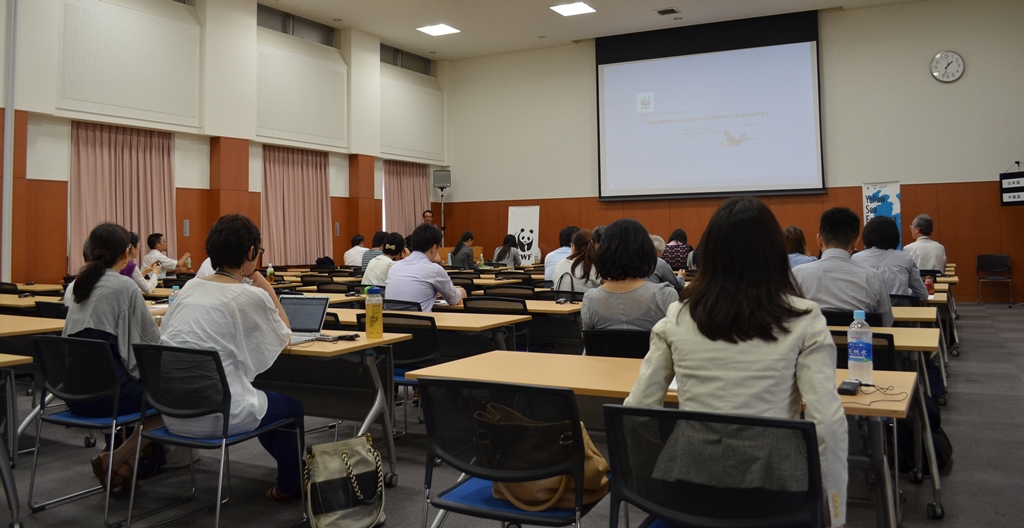Shigeki Yasumura, WWF Japan
On 28 May 2015, WWF Japan organised a seminar on “Sustainable Seafood Market Dynamics in China and Yellow Sea Conservation” in Tokyo, Japan. The seminar introduced the current status of marine fisheries and the rich biodiversity of Yellow Sea to Japanese major retailers and buyers of marine products and those who were interested in wetland conservation. Speakers and participants discussed future actions and cooperation.
Detailed report in Japanese with full presentations is available here.
Background
China is one of the largest seafood suppliers to the Japanese seafood market – in 2012 over 400,000 MT of seafood including processed products were imported from China. The Yellow Sea is on a continental shelf, extending from the coast of China to the coast of Korean Peninsula. It supports large populations of marine life as well as migratory bird species. Not only local communities, but also Japan and neighboring countries rely on its well-functioning ecosystem services.
Lately, Japanese market players, in particular retailers and buyers who expand their business to global market, are becoming aware of the importance of sustainable procurement of seafood from China. Therefore, many of them are seeking information as well as advice to establish adequate policies to ensure sustainable seafood, which fit both the Japanese seafood consuming culture and Chinese-Japanese supply chain system. Yet, there are few opportunities for Japanese buyers and retailers to obtain adequate information about the sustainability of Chinese seafood products.
With in the context, WWF have organized the first ever seminar about problems associated with the current growth of Chinese seafood business and introducing the movement of seafood sustainability in China. Also, WWF presented a case study in a high conservation value wetland in the Yellow Sea, which revealed ecological linkages among local fishing practice, bird migration and the biomass of the species that forage in the tidal flats, aiming to promote ecosystem-based fishery and wetland management.
Goal
Given the growing supply of the Chinese seafood products, WWF aims to advise the Japanese buyers with risks, problems, challenges and opportunities associated with the Chinese fishery and seafood supply chain. To lower the risks, Japanese companies are advised to contribute to protecting high conservation value areas in China, and require Marine Stewardship Council (MSC) and Aquaculture Stewardship Council (ASC) certification along with their partners in China.
Objectives
Develop buyers and retailers awareness of the relationship between their seafood procurement and marine environmental issues in China.
Inform and highlight the potential contribution of Japanese market players to marine conservation in China.
Recommend practical solutions for transforming Chinese and Japanese supply chains through transparent traceability.
Assess current status of interest in developing sustainable procurement policies amongst key Japanese retailers, processors and traders (importers).
Seminar ©WWF Japan
Presenters
Ms Chen Lichun, China Aquatic Products Processing & Marketing Association (CAPPMA)
Chinese fisheries and the dynamics of sustainable seafood consumption
Dr Leng Chuanhui, Liaoning Ocean and Fishery Research Institute (LOFSRI)
Scanning of the mudflat clam industry in the Yellow Sea Ecoregion
Ms Li Yeqing, WWF China
Enhancing sustainable seafood work in China through sustainable
retail – round table discussion
Mr Zhou Haixiang Shengyang Ligong University
Ecological services of the northern shore of the Yellow Sea and the current situation
Ms Wang Ying, WWF China
Coastal wetland conservation practices in the Yellow Sea Ecoregion
Mr Yasumura Shigeki, WWF Japan
Brief introduction of the Yellow Sea Ecoregion project and the connections between China and Japan
Key Messages
- Current status of the Japan-China supply chain, and the Chinese seafood market
- Sustainability Issues
- WWF case study and market partners’ contributions to conserving Yellow Sea biodiversity
After the presentations, a panel discussion about “Promotion of sustainable seafood in collaboration with Japan and China” was held.
Related websites
- Detailed report in Japanese with full presentations
- An initiative on Yellow Sea Ecoregion Support Project (YSESP) lead by WWF Japan: Link in English / Japanese. YSESP materials in English, Chinese and Korean are also available here.
- EAAFP Yellow Sea Ecoregion Task Force









